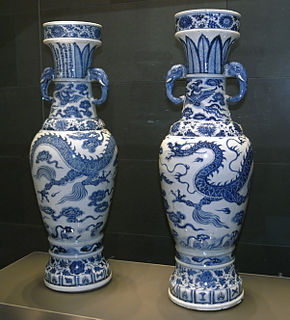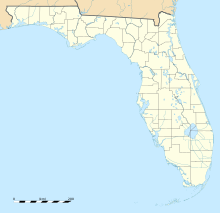
The Victoria and Albert Museum in London is the world's largest museum of decorative arts and design, housing a permanent collection of over 2.27 million objects. It was founded in 1852 and named after Queen Victoria and Prince Albert.

Vitreous enamel, also called porcelain enamel, is a material made by fusing powdered glass to a substrate by firing, usually between 750 and 850 °C. The powder melts, flows, and then hardens to a smooth, durable vitreous coating. The word comes from the Latin vitreum, meaning "glassy".
The former Tsui Museum of Art in Hong Kong housed a privately owned collection.
A vase is an open container. It can be made from a number of materials, such as ceramics, glass, non-rusting metals, such as aluminium, brass, bronze or stainless steel. Even wood has been used to make vases, either by using tree species that naturally resist rot, such as teak, or by applying a protective coating to conventional wood. Vases are often decorated, and they are often used to hold cut flowers. Vases come in different sizes to support whatever flower its holding or keeping in place.

The Percival David Foundation of Chinese Art is a collection of Chinese ceramics and related items, on permanent display in its own gallery in Room 95 at the British Museum. The Foundation's main purpose is to promote the study and teaching of Chinese art and culture. The collection consists of some 1,700 pieces of Song, Yuan, Ming and Qing dynasty porcelain from the 10th century to the 18th, as well as a painting, Scroll of Antiquities dating from the Yongzheng (1723–35) reign.

A demitasse is a small cup used to serve Turkish coffee or espresso.

The manufacture nationale de Sèvres is one of the principal European porcelain manufactories. It is located in Sèvres, Hauts-de-Seine, France. It is the continuation of Vincennes porcelain, founded in 1738, which moved to Sèvres in 1756. It has been owned by the French crown or government since 1759, and has always maintained the highest standards of quality. Almost immediately, it replaced Meissen porcelain as the standard-setter among European porcelain factories, retaining this position until at least the 19th century.

The Yale University Art Gallery houses a significant and encyclopedic collection of art in several buildings on the campus of Yale University in New Haven, Connecticut. Although it embraces all cultures and periods, the gallery emphasizes early Italian painting, African sculpture, and modern art.

The Museum of Royal Worcester is a ceramics museum located in the Royal Worcester porcelain factory's former site in Worcester, England.

Joseon white porcelain or Joseon baekja refers to the white porcelains produced during the Joseon dynasty (1392-1910).

The Cummer Museum of Art and Gardens is a museum located in Jacksonville, Florida. It was founded in 1961 after the death of Ninah Cummer, who bequeathed her gardens and personal art collection to the new museum. The Cummer Museum has since expanded to include the property owned by Ninah's brother-in-law, but it still includes her original garden designs and a portion of her home with its historic furnishing. The museum and gardens attract 130,000 visitors annually.

Rudolf Staffel was an American ceramic artist and arts educator.

The Museum of Science & History (MOSH) is a museum in Jacksonville, Florida. It is a private, non-profit institution located on the Southbank Riverwalk, and the city's most visited museum. It specializes in science and local history exhibits. It features a main exhibit that changes quarterly, three floors of permanent exhibits, and the Bryan-Gooding Planetarium.
Bryan-Gooding Planetarium in the Alexander Brest Science Theatre is a planetarium in the Museum of Science and History in Jacksonville, Florida, U.S. It was built in 1988 and featured a 60-foot-diameter (18 m) dome-shaped projection screen, JBL stereo sound system, and a Zeiss Jena Optical mechanical planetarium star projector. The facility has seating for 200, and approximately 60,000 people see a planetarium show each year.
David Revere McFadden is Chief Curator and Vice President for Programs and Collections at the Museum of Arts & Design in New York City.

A ceramics museum is a museum wholly or largely devoted to ceramics, usually ceramic art. Its collections may also include glass and enamel, but typically concentrate on pottery, including porcelain. Most national collections are in a more general museum covering all of the arts, or just the decorative arts. However, there are a number of specialized ceramics museums, with some focusing on the ceramics of just one country, region or manufacturer. Others have international collections, which may be centered on ceramics from Europe or East Asia or have a more global emphasis.
Education in Jacksonville, Florida is available through both public and private sources.

Ann Walsh is a visual artist, primarily working with paint, Plexiglas and vinyl. Her work has been displayed in The Everson Museum of Art, the Portland Museum of Art, the Saint-Gaudens National Historic Site and the Lori Bookstein Gallery, among others.

Ceramic art is art made from ceramic materials, including clay. It may take forms including art ware, tile, figurines, sculpture, and tableware. Ceramic art is one of the arts, particularly the visual arts. Of these, it is one of the plastic arts. While some ceramics are considered fine art, as pottery or sculpture, some are considered to be decorative, industrial or applied art objects. Ceramics may also be considered artefacts in archaeology. Ceramic art can be made by one person or by a group of people. In a pottery or ceramic factory, a group of people design, manufacture and decorate the art ware. Products from a pottery are sometimes referred to as "art pottery". In a one-person pottery studio, ceramists or potters produce studio pottery.
















